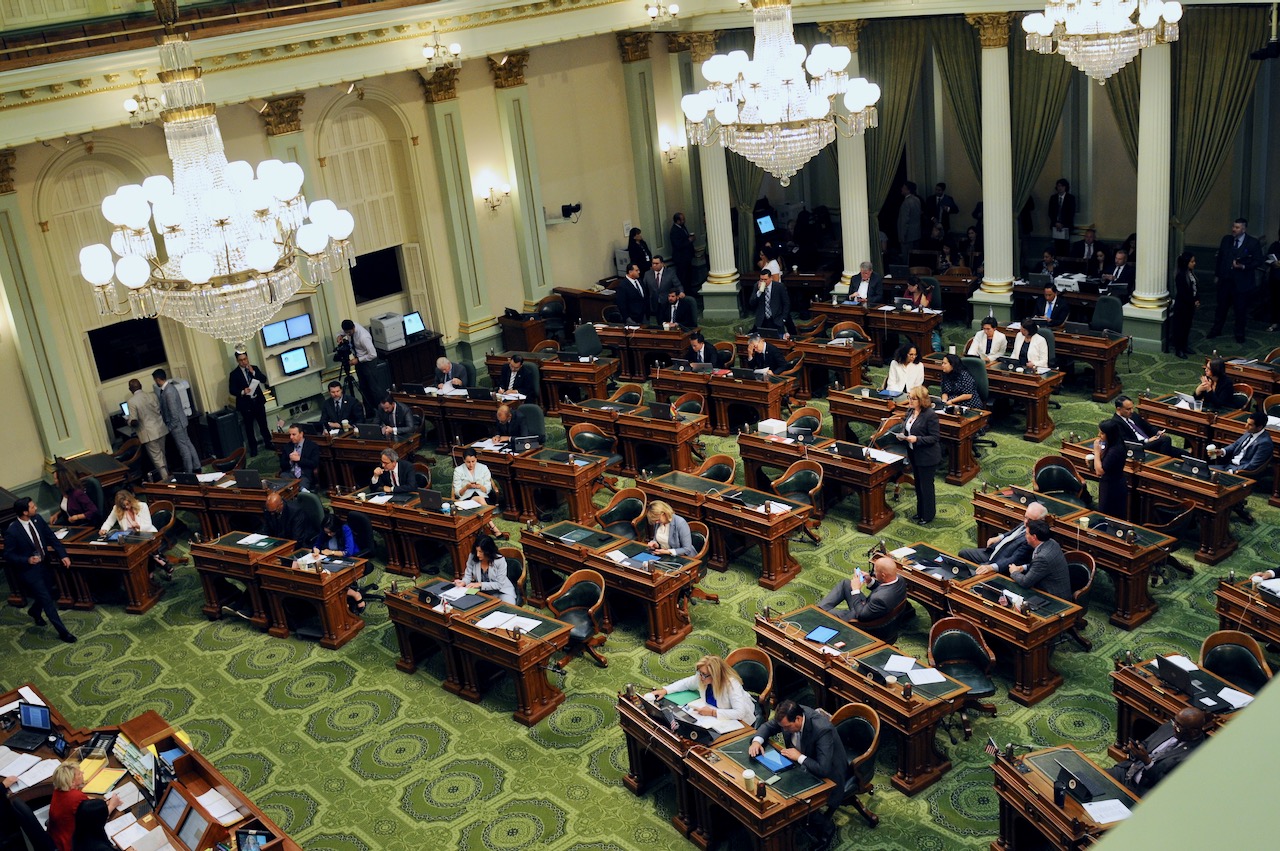
Gov. Gavin Newsom. (Photo: Kevin Sanders for California Globe)
Bill To ‘Combat Biodiversity and Climate Crises’ Fails in the Legislature, but Resurrected as Executive Order
Gov. Newsom issues Executive Order so similar to failed climate bill
By Chris Micheli, October 7, 2020 2:59 pm
Two bills would have established new land, water, and ocean protection goals, including to protect 30 percent of the state’s land areas and water by 2030.
Assembly Bill 3030, by Assembly Member Ash Kalra (D-San Jose), as well as AB 2954, by Assembly Member Robert Rivas (D-San Benito), passed the State Assembly but was held on the Senate Appropriations Committee’s Suspense File in mid-August and therefore failed passage in the recently-concluded 2020 Legislative Session. Nonetheless, on October 7, Governor Newsom issued EO-N-82-20 which sounds very similar to the provisions of AB 3030.
Provisions of AB 3030
In Section 1 of the bill, there were 18 legislative findings and declarations, including that “access to public land, nature, and a healthy environment should be a right for all people…” Also, “the Natural Resources Agency has made environmental justice and tribal consultation a priority…” Moreover, “scientists are documenting a rapid loss of natural areas and wildlife in California.”
Also, “California should protect land, water, ocean, and wildlife in the state as necessary to prevent the further decline of nature. This act is not intended to undermine the Fish and Game Commission’s authority in managing the public trust resources of the state. Conserving and restoring nature is one of the most efficient and cost-effective strategies for fighting climate change. The implementation of this policy includes promoting voluntary cooperation with private land owners.”
Additional findings and declarations stated that, “as a step toward achieving that goal, scientists have recommended that all countries commit to conserving and protecting at least 30 percent of land areas and waters and 30 percent of the ocean in each country by 2030, with a long-term goal of conserving one-half of the planet. Implementation of a state policy to protect at least 30 percent of California’s land areas and waters within the state and 30 percent of the nation’s oceans by 2030 should be consistent with state housing and economic goals.”
In Section 2 of the bill, Section 9001.6 would have been added to the Public Resources Code. Subdivision (a) defined the terms “protect” and “protection.” Subdivision (b) provides that “it is the goal of the state to protect at least 30 percent of California’s land areas and waters and to help advance the protection of 30 percent of the nation’s oceans by 2030, inclusive of existing protections afforded by state and federal laws and regulations.”
Subdivision (c) specifies that it “is further the goal of the state to support regional, national, and international efforts to protect at least 30 percent of the world’s land areas and waters and 30 percent of the world’s ocean by 2030.” Subdivision (e) permits the state to “achieve the goals established in this section through activities that include, but are not limited to, any of the following:
- Working with the federal government, local communities, Native American tribes and tribal entities, other countries, willing private landowners, and recreational and commercial stakeholders to conserve natural places and resources.
- Improving access to nature for all people in the state, with a specific emphasis on increasing access for communities of color and economically disadvantaged communities.
- Preventing extinction by recovering and restoring biodiversity, including species listed under the California Endangered Species Act (Chapter 1.5 (commencing with Section 2050) of Division 3 of the Fish and Game Code).
- Enhancing climate resilience by protecting genetic diversity.
- Sequestering carbon and greenhouse gas emissions through natural measures in the land, waters, and ocean.
- Focusing work at a scale that is biologically and ecologically meaningful, including at a landscape or seascape scale, where appropriate.
- Collaborating with federal, tribal, regional, and international governments to support and advance protections for terrestrial and marine habitats that lie outside of the state’s jurisdiction to ensure effective protections for California species that travel, are migratory, or have ranges that extend beyond the borders of the state.
- Considering how existing processes to evaluate or strengthen environmental conservation in California can contribute to the goals described in subdivisions (b) and (c) and leveraging those processes to identify, evaluate, and implement measures to meet the goals described in subdivisions (b) and (c).
- Stabilizing ecosystems and the services of ecosystems, restoring degraded ecosystems, and maintaining and enhancing ecological functions, including functional ecological connectivity in the face of human impact and climate change.
- Aligning the state’s economic and purchasing power with efforts to protect ecosystems and threatened biodiversity within the state, nationally, and internationally.
- Ensuring that protected areas within the state are effectively managed and enforced.
- Securing protections for habitat types that are underrepresented in protected areas.
- Consulting with Native American tribes when conservation efforts impact tribal ancestral homelands to help restore tribal access to those lands and maintain or restore tribal land management, stewardship, and ownership.
- Partnering with Native American tribes to learn from and apply traditional ecological knowledge and reintroduce and promote traditional practices to restore ecosystem interconnectivity and balance, including through cooperative management agreements and other related legal instruments.
Subdivision (f) requires the Natural Resources Agency to ensure that actions made in furtherance of this section are conducted in a manner that incorporates the agency’s environmental justice and tribal consultation policies, including subsequent updates to those policies, into relevant program planning, development, and implementation decisions. Finally, subdivision (g) specifies that this section does not undermine, limit, contravene, or modify any other law or regulation in effect on January 1, 2021.
Provisions of AB 2954
In Section 1 of the bill, there were over a dozen legislative findings and declarations, including that “climate change is causing historic droughts, devastating wildfires, torrential storms, extreme heat, the death of millions of trees, billions of dollars in property damage, and threats to human health and food supplies. The state’s forests, agricultural and ranch lands, wetlands, oceans, and other natural and working landscapes define the beauty and well-being of our state, but tragically are suffering increasing degradation caused by a changing climate.”
Moreover, “While the state’s natural and working landscapes confront impacts from climate change, they continue to provide a valuable carbon sequestration service that can help the state meet its long-term climate, public health, environmental, and economic goals.” It also noted that the state has taken a number of specific steps to reduce greenhouse gas emissions.
Section 2 of the bill, Section 38561.5 would have been added to the Health and Safety Code. Subdivision (a) would have added definitions for the terms “natural lands” and “working lands.” Subdivision (b) would have required, as part of the next update to the scoping plan prepared, the state board, in collaboration with the relevant state agencies and departments, to do all of the following:
- Identify by January 1, 2023, an overall climate goal for the state’s natural and working lands to sequester carbon and reduce atmospheric greenhouse gas emissions. The climate goal shall support the state’s efforts to achieve carbon neutrality and resilience to climate impacts.
- Identify practices, policy incentives, and potential reductions in barriers that would help achieve the climate goal established pursuant to paragraph (1).
- Integrate opportunities to enhance other important public benefits and needs, including, but not limited to, the enhancement of water and air quality, climate resilience, public health, biodiversity, jobs, species habitat, the production of food and fiber, public access to recreation, and the protection of vulnerable communities against climate impacts.
- Develop methods for state agencies to consistently track greenhouse gas emissions reductions, carbon sequestration, and cobenefits from natural and working lands over time.
Provisions of Executive Order N-82-20
The Governor’s new Executive Order includes 11 “whereas” clauses. For example, “WHEREAS California’s natural and working lands – our forests, rangelands, farms, wetlands, coast, deserts, and urban greenspaces – sustain our economy, support our unique biodiversity, contribute to the global food supply, support outdoor heritage and provide clean water and air.”
In addition, “WHEREAS California’s rich biodiversity is increasingly threatened by loss of habitat, spread of invasive species, decreasing water supplies, and increasingly frequent and severe climate impacts.” Also, “WHEREAS as we work to mitigate greenhouse gas emissions, we must also accelerate actions to enable the State to adapt and become more resilient to the impacts of climate change, including expanding nature-based solutions – the use of sustainable land management practices to tackle environmental, social and economic challenges.”
Governor Newsom ordered, in order to “combat the biodiversity and climate crises, the California Natural Resources Agency, in consultation with the California Department of Food and Agriculture, the California Environmental Protection Agency and other state agencies, is directed to establish the California Biodiversity Collaborative (Collaborative) to bring together other governmental partners, California Native American tribes, experts, business and community leaders and other stakeholders from across California to protect and restore the State’s biodiversity.”
In addition, State agencies will consult the Collaborative on efforts to:
a. Establish a baseline assessment of California’s biodiversity that builds upon existing data and information, utilizes best available science and traditional ecological knowledge, and can be updated over time.
b. Analyze and project the impact of climate change and other stressors on California’s biodiversity.
c. Inventory current biodiversity efforts across all sectors and land managers and highlight opportunities for additional action to preserve and enhance biodiversity.
d. Expand the communication and use of information, indicators and tools to monitor, track and protect California’s biodiversity and natural resources.
e. Advance multi-benefit, voluntary and cooperative approaches that protect and restore biodiversity while stewarding natural and working lands, building climate resilience, and supporting economic sustainability.
f. Engage stakeholders across California’s diverse communities, including academic and research institutions; local and federal governments; California Native American tribes; outdoor recreation and access groups; fishing and hunting organizations; farmers, ranchers and other private landowners and land managers; environmental advocates and investors; housing and land use developers; educators; philanthropy, and others.
In addition, the Executive Order specifies that, in order to “support the global effort to combat the biodiversity and climate crises, it is the goal of the State to conserve at least 30 percent of California’s land and coastal waters by 2030.” And, the California Natural Resources Agency and other relevant state agencies, in consultation with the Collaborative, are directed to develop and report strategies to the Governor no later than February 1, 2022 to achieve this goal.”
In working to achieve this goal, state agencies are to do so in a manner that:
a. Safeguards our State’s economic sustainability and food security.
b. Protects and restores biodiversity.
c. Enables enduring conservation measures on a broad range of landscapes, including natural areas and working lands, in partnership with land managers and natural resource user.
d. Builds climate resilience, reduces risk from extreme climate events and contributes to the State’s effort to combat climate change.
e. Expands equitable outdoor access and recreation for all Californians
Moreover, the Executive Order directs the Natural Resources Agency, in order to advance efforts to conserve biodiversity, to take the following actions within existing authority and resources:
a. Strategically prioritize investments in cooperative, high-priority actions that promote biodiversity protection, habitat restoration, wildfire-resilient, sustainably managed landscapes and other conservation outcomes.
b. Implement actions to increase the pace and scale of environmental restoration and land management efforts by streamlining the State’s process to approve and facilitate these projects.
c. Collaborate with federal and state research institutions to utilize innovative scientific observation technology and with tribal partners to incorporate tribal expertise and traditional ecological knowledge to better understand our biodiversity and threats it faces.
d. Participate in regional, national and international efforts to advance biodiversity protection and help to stem extinctions across the planet.
The Executive Order directs the California Department of Food and Agriculture to take the following actions with existing authority and resources:
a. Coordinate with other relevant state agencies and private partners to reinvigorate populations of pollinator insects across the State, which restore biodiversity and improve agricultural production.
b. Implement strategic efforts to protect California’s native plants and animals from invasive species and pests that threaten biodiversity and economic activities.
c. Enhance soil health and biodiversity through the Healthy Soils Initiative.
Next, the Executive Order requires within one year that the California Natural Resources Agency, in consultation with the California Environmental Protection Agency, the California Department of Food and Agriculture, the California Air Resources Board, Governor’s Office of Planning and Research, the California Strategic Growth Council and other state agencies, to develop a Natural and Working Lands Climate Smart Strategy that serves as a framework to advances the State’s carbon neutrality goal and builds climate resilience.
In developing this Strategy, agencies are required to be guided by the following principles:
a. Promote healthy lands that provide multiple benefits including improved air quality, reliable water supply, thriving communities, and economic sustainability.
b. Advance equity and opportunity for all regions of California.
c. Support pathways for sectors such as agriculture and forestry to participate in the transition to a carbon neutrality economy.
d. Inform policies through public feedback gathered through extensive outreach to and equitable engagement with stakeholders including, but not limited to, land managers, federal, tribal and local governments, communities, environmental justice leaders, businesses, investors, nongovernmental organizations, scientists and universities.
e. Align policies, programs, and funding mechanisms across state government, while identifying opportunities to catalyze and accelerate private investment and actions that contribute to the State’s carbon neutrality goal.
Finally, as part of the next Scoping Plan process, the California Air Resources Board, in coordination with relevant state agencies, is required to take into consideration the Natural and Working Lands Climate Smart Strategy and science-based data to update the target for the natural and working lands sector in achieving the State’s carbon neutrality goal. And, the California Department of Food and Agriculture must work with agricultural stakeholders to identify farmer- and rancher-led solutions to inform the next Scoping Plan process.
- Procedures for Adult Adoptions - December 17, 2025
- Quiz on Where Areas of Law Are Found in the California Codes - December 16, 2025
- Sister State Money Judgments - December 16, 2025





Why doesn’t Newsom issue an executive order banishing the state legislature and make himself King of Kalifornia for life? He is 9/10 there already.
HOGWASH! This idiot for a governor is spending time on this?! My head exploded reading this!
Governor Brown was bad, but this guy is insufferable…
He is not King of the “nation state of California” and why is he not being challenged in court by the CAGOP for executive overreach???
#Judicial Watch where are you???
I put our recall Newsom sign out this weekend…
http://www.recallgavin2020.com
He is currently being challenged in court by Assemblymen Kiley and Gallagher to invalidate EVERY SINGLE ONE of his emergency powers.
I, “Gavin the First,” have spoken.
Newsolini, changing California one E.O. at a time…
Hello dystopia!
Just a little FYI, his “First Partner”, Jennifer Newsom has a new film out entitled, “ The American Lie”.
They are true partners as they work to convince us that the America we have all lived in is wrong. This ties into his new orders, such as the electric car order and the new catch for reopening the state that all counties must address the inequities in the latin and black communities before they allow indoor dining and worship. The irony of course that this actually hurts those communities and bars them from making a living!
The rest of the USA has further evidence that progressivism, takes away our liberty and pursuit in happiness!
At this point why even have a state legislature, when makes decrees every week. I agree with @ExCali we need Judicial Watch! This has to be illegal!
@ONE FED UP CALI GIRL
It’s called The GREAT American Lie. You can buy on Amazon Prime but why would we? It has 1 review (no name), which I can only guess is Gavin. The only motive to purchase her shitty movie would be to leave a shitty review.
Some other movies by Jennifer Seibel (Newsome):
Miss Representation
The Mask You Live In
(both of these no longer avail on Prime, prob due to numerous neg feedback from disgruntled Californians. You can buy the DVDs but not thru PRIME. So Amazon eliminated the ability to purchase in order to leave a shitty review, then send back).
Thanks for the correction and the extra info on the movie, Jennifer.
Comrades
In semi rural areas it will cost you triple to change a window or door due to eco-regulation, property, in general, will have encumbrances and restrictions that Stalin would only have approved…….
The friction, sense of betrayal and general distaste of smothering government…….Ah….
This is EXACTLY the same goals as similarly outlined in the “UN Agenda 21 Sustainable Development” and The 2030 Agenda which is part of UN Agenda 21. It should be no surprise that the nephew of Nancy Pelosi is the one to do it…. Nancy Pelosi authored HConRes 353 in 1992 urging Congress to implement UN agenda 21 sustainable development into the United States. Here’s the proof: https://youtu.be/TwZumWFOeEw
Important insights. But author Chris Micheli should at least get the article’s title correct. It’s not a “Bill To ‘Combat Biodiversity…’! Even in the bullet points, a stated goal is in the “recovering and restoring biodiversity”.